A
Premier Train Show
International Railfair
[The
Northern California Model Train
Show]
***
Another Veteran's Day weekend passed in Roseville, CA with the Northern California Model Train Show. As usual, it was a great show with many vendors, live steam, European and U.S. prototype model train layouts. The Pennsylvania Railroad may have passed into history in 1968 but its fan's live on, modeling the "Standard Railroad of the World" in many scales. Below is a photo of the live steam PRR B-6sb switcher that was on display at the show.
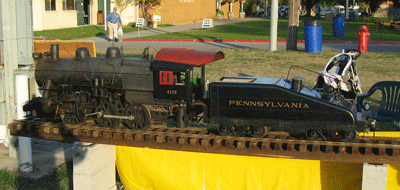
There was even a model under development of Pennsy's characteristic N6b "cabin car". It will be a beauty when it is finished. We hope to show the finished model next year.
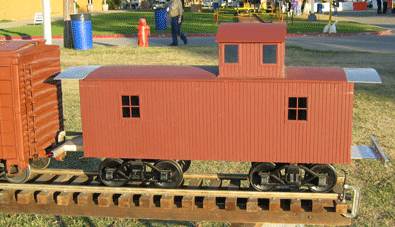
Trolleyville vendors Custom Traxx, Holland Traction Products, Light Rail Products, MTS Imports and Railway/Traction Miniatures were on hand for this fine show. Custom Traxx had their normal HO scale traction demonstration module, shown below, equipped with models of San Francisco SLRV 1213. Sacramento Northern Railway Holman combine 1004, San Francisco MUNI PCCs 1024 (green) and 1038 (orange) along with Twin Cities PCC 396 and Toronto Transportation Commission ex-Kansas City PCC 4777. All units are Bowser powered.
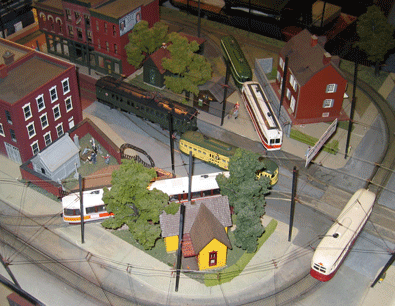
We reviewed this show in our December 2004 edition and concluded that these people really know how to put on a great train show. The first thing that they do is take care of the vendors, making sure that they are happy when the show opens. Advertising my media and word of moth is plentiful and the excellence of each show speaks volumes for itself. The Rainbow Girls serve a great breakfast for exhibitors during Saturday morning and Sunday morning set up.
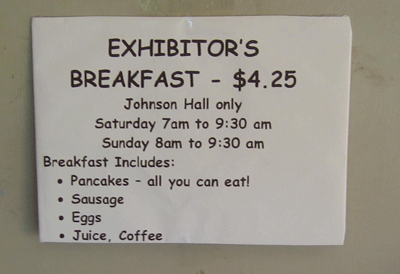
The pancakes were "all you can eat" and they were really delicious . The Rainbow Girls also had some tri-tip sandwiches available on Friday evening for the early vendor set-up and they ran out of them so they intend to have more next year. They have a full menu of reasonably priced, excellent food all during the show.
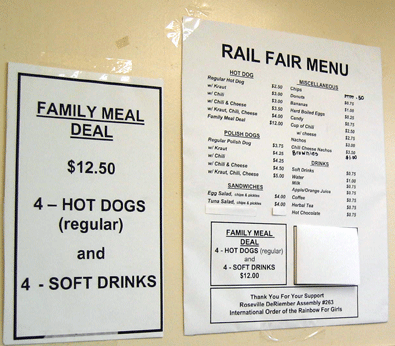
So
if you can manage to be in the
Sacramento area during the 2006
Veteran's Day weekend, drop in
and enjoy yourself, visit the
show, visit the Western Railway
Museum and then go to San Francisco
and enjoy the trolleys.
_____________________________________________________
Boeing
Standard Light Rail Vehicles
from IHC!
***
The Times learned during this month that the Boeing Standard Light Rail Vehicles are again available from IHC. Both the Boston and San Francisco liveries are available. There have been some minor changes but the unit is essentially the same as those previously produced except that the wheels are now blackened as the last photo in this article shows.
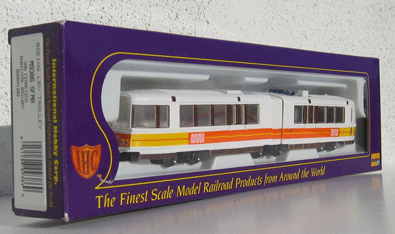
We obtain one of the San Francisco MUNI units, stock number #9386 as shown above and ran it on a test track along with one of the old ones and found that they ran at essentially the same speeds, so train operation is possible with both the new and the older cars. As was the case with the earlier produced units, the San Francisco colors are quite wrong being yellow and orange instead of orange and red. But a complete decal set for correctly finishing these cars is available from Custom Traxx. Set CN-1220 is available for $12.95. Custom Traxx also has a complete replacement mechanism available for these cars. the unit, #125147 is manufactured by Bowser Manufacturing exclusively for Custom Traxx. Units with these mechanisms and finished using the Custom Traxx CN-1220 decal set were operated at the East Penn Traction Club Meet last May in Philadelphia. Check the Custom Traxx catalog for more details.

Another
HO Repowering:
The CL&A Lightweight
Interurban from Fairfield
***
The Cincinnati, Lawrenceburg & Aurora Railroad Company received seven little interurban cars from the Cincinnati Car Co. in 1918. These cars, 915-921, were revolutionary at the time as they had low floors due to small 24 inch wheels on 5' 8" wheel base trucks. The cars, with their four 25 horsepower motors, ran on the CL&A until 1930 when the company ceased operation. After a few years of storage, they were sent to Oklahoma where they ran on the Sand Springs Railway, where they ran as 62-68 until 1948 when they were finally retired after nearly thirty years of service. One car, 68, has been preserved at the Illinois Railway Museum.
Fairfield Traction Models imported 300 of these models in 1966 and in 1968, an HO scale model of one of these little cars was obtained from Gager's Handicraft in Minneapolis. It never ran too well due to an erratic open frame motor. Of course, the exact paint scheme for the Cincinnati, Lawrenceburg & Aurora car was not immediately available but there was a paint scheme hinted on page 38 of the New Second Edition of the Traction Planbook, published also in 1968, so the car was brush painted and placed back in the box.
During 1985, the car was shown to a motor specialist at Model Die Casting, which was then located in Hawthorne, California. He took the car and repaired the motor and the car ran fine, so the car was run in a two rail fashion and, again, placed back in the box.
After obtaining a copy of Traction Classics, Volume Two - The Interurbans - Extra Fast and Extra Fare, by William D. Middleton and finding the CL&A car as the first item in the book, the car, now with another 20 years of dust on the box, was chosen for another repowering article.
As in the case of last month's repowering, the totally assembled vehicle weighed 6.0 ounces (oz). The model ran fine in the two-rail mode with that weight. Our rule of thumb for a 40ft long car such as this is 8 oz. So we kept track of the weight of any items to be added and those removed. First, we removed the power chassis and noted that the vertical distance from the motor shaft and the chassis floor was 3.5 scale feet. The motor and bracket were then removed and weighed at 1.5 oz.
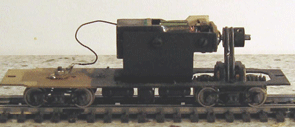
Keeping this distance between the motor shaft and the chassis floor would maintain the spring belt drive in the same configuration that already proved to be workable. The A-line 40324 motor would be used for this repowering and due to its small size, it would have to be raised from the floor by a combination of A-line cradle and styrene. This motor weighed only 0.7 oz and depending on our choice of flywheel, another .6 to 1.0 oz would be added. With the 1.0 oz A-line 12401 cradle added, we estimated that we would be adding 2.3 to 2.7 oz to the car after removing 1.5 oz.
In preparation for the motor mounting, the A-line 12401 cradle, originally 36 mm long, was cut to 25 mm and the remaining 11 mm portion was set aside. After the final position of the cradle was ascertained, three 25mm pieces of Evergreen Strip styrene #189 (.125" x .250") were cut and installed side by side on the chassis floor with Gorilla Glue. We learned to use this adhesive sparingly as it expands as it dries. The cradle was then secured to the top of the styrene with the same Gorilla Glue. The remaining 11mm piece of the cradle was then placed behind the styrene and secured with the same Gorilla Glue. For best performance, an A-line 20006 flywheel was used. The original motor pulley was attached to the motor shaft after the shaft had been increased to 2.4 mm with the addition of an A-Line #12053 2.0 mm to 2.4 mm bushing which was secured to the shaft with a very small amount of A-line Flywheel Cement.
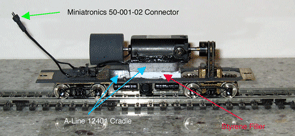
As a final touch, since the Southern California Traction Club appears eight to twelve time each year and runs many cars, we need to be able to take the cars apart for service and repairs. We always use a Miniatronics connector for attaching the chassis electrically to the body shell. In most cases this is the Miniatronics 50-001-02 2-pin connector. Our convention is to mount the female plug on the shell and the male connector on the chassis. The white wire goes to the rear pole. In most cases, the front of the car is the power truck end. The two Clover House printed circuits strips are affixed to the roof of the car. One is attached to each trolley pole. Any installed headlights will be electrically connected to these strips. Below is a view of the CL&A shell just prior to assembly.
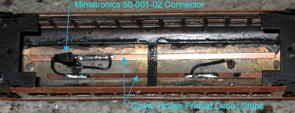
The final photo is the 1968 brush painted shell after mounting on the remotored chassis. this car, now weighing 7.7 oz was then tested on the Southern California Traction Club test track. The unit ran at 46 scale miles per hour at 7.0 volts. We are now aware that the paint scheme shown is very wrong and that actual CL&A scheme was medium green. The pictured car has already been stripped and is in the process of being repainted. This will be more detailed in a future Custom Traxx decal set that should be released during 2006. Decals for these cars in both the CL&A (CN-915) and SSRyCo (CN-68) dress will be available.
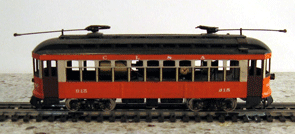
We discovered that we had a second CL&A interurban and decided to convert it into Sand Springs 65. This would require headlights to be installed at both ends and pole towers to be fabricated.
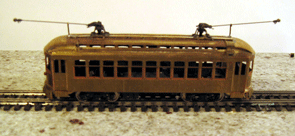
Today, there are so many really good motors available for repowerings that were not even a dream when these brass trolleys were imported. In the SSRyCo 65, we used a NWSL 20275-9, 9800 RPM @ 12 volt motor with an A-line 20006 flywheel mounted on an A-line 12401 cradle. This one required us to remove 1/4 " from each of the spring belts. The final chassis is shown below:
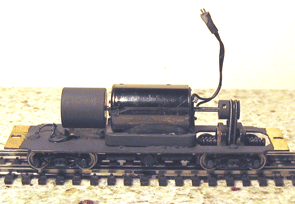
As
a final note, these repowering articles
are not intended to be the last
word on repowerings. They are all
repowerings that have worked and
the cars have run for multiple hours
on the Southern California Traction
Club modules without incident. We
would be glad to print repowering
articles submitted by other traction
fans, when they are submitted to
us electronically preferably in
MS Word format.